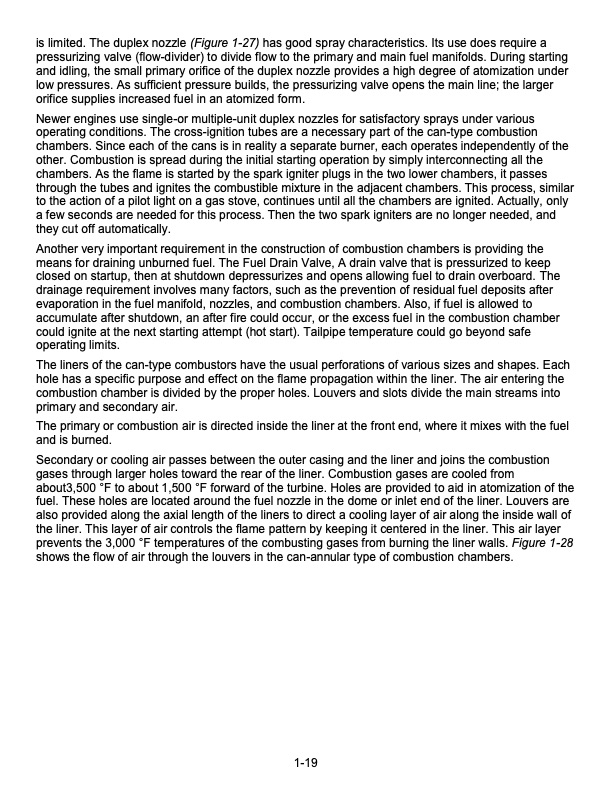
PDF Publication Title:
Text from PDF Page: 019
is limited. The duplex nozzle (Figure 1-27) has good spray characteristics. Its use does require a pressurizing valve (flow-divider) to divide flow to the primary and main fuel manifolds. During starting and idling, the small primary orifice of the duplex nozzle provides a high degree of atomization under low pressures. As sufficient pressure builds, the pressurizing valve opens the main line; the larger orifice supplies increased fuel in an atomized form. Newer engines use single-or multiple-unit duplex nozzles for satisfactory sprays under various operating conditions. The cross-ignition tubes are a necessary part of the can-type combustion chambers. Since each of the cans is in reality a separate burner, each operates independently of the other. Combustion is spread during the initial starting operation by simply interconnecting all the chambers. As the flame is started by the spark igniter plugs in the two lower chambers, it passes through the tubes and ignites the combustible mixture in the adjacent chambers. This process, similar to the action of a pilot light on a gas stove, continues until all the chambers are ignited. Actually, only a few seconds are needed for this process. Then the two spark igniters are no longer needed, and they cut off automatically. Another very important requirement in the construction of combustion chambers is providing the means for draining unburned fuel. The Fuel Drain Valve, A drain valve that is pressurized to keep closed on startup, then at shutdown depressurizes and opens allowing fuel to drain overboard. The drainage requirement involves many factors, such as the prevention of residual fuel deposits after evaporation in the fuel manifold, nozzles, and combustion chambers. Also, if fuel is allowed to accumulate after shutdown, an after fire could occur, or the excess fuel in the combustion chamber could ignite at the next starting attempt (hot start). Tailpipe temperature could go beyond safe operating limits. The liners of the can-type combustors have the usual perforations of various sizes and shapes. Each hole has a specific purpose and effect on the flame propagation within the liner. The air entering the combustion chamber is divided by the proper holes. Louvers and slots divide the main streams into primary and secondary air. The primary or combustion air is directed inside the liner at the front end, where it mixes with the fuel and is burned. Secondary or cooling air passes between the outer casing and the liner and joins the combustion gases through larger holes toward the rear of the liner. Combustion gases are cooled from about3,500 °F to about 1,500 °F forward of the turbine. Holes are provided to aid in atomization of the fuel. These holes are located around the fuel nozzle in the dome or inlet end of the liner. Louvers are also provided along the axial length of the liners to direct a cooling layer of air along the inside wall of the liner. This layer of air controls the flame pattern by keeping it centered in the liner. This air layer prevents the 3,000 °F temperatures of the combusting gases from burning the liner walls. Figure 1-28 shows the flow of air through the louvers in the can-annular type of combustion chambers. 1-19PDF Image | JET ENGINE THEORY AND DESIGN

PDF Search Title:
JET ENGINE THEORY AND DESIGNOriginal File Name Searched:
14008A_ch1.pdfDIY PDF Search: Google It | Yahoo | Bing
NFT (Non Fungible Token): Buy our tech, design, development or system NFT and become part of our tech NFT network... More Info
IT XR Project Redstone NFT Available for Sale: NFT for high tech turbine design with one part 3D printed counter-rotating energy turbine. Be part of the future with this NFT. Can be bought and sold but only one design NFT exists. Royalties go to the developer (Infinity) to keep enhancing design and applications... More Info
Infinity Turbine IT XR Project Redstone Design: NFT for sale... NFT for high tech turbine design with one part 3D printed counter-rotating energy turbine. Includes all rights to this turbine design, including license for Fluid Handling Block I and II for the turbine assembly and housing. The NFT includes the blueprints (cad/cam), revenue streams, and all future development of the IT XR Project Redstone... More Info
Infinity Turbine ROT Radial Outflow Turbine 24 Design and Worldwide Rights: NFT for sale... NFT for the ROT 24 energy turbine. Be part of the future with this NFT. This design can be bought and sold but only one design NFT exists. You may manufacture the unit, or get the revenues from its sale from Infinity Turbine. Royalties go to the developer (Infinity) to keep enhancing design and applications... More Info
Infinity Supercritical CO2 10 Liter Extractor Design and Worldwide Rights: The Infinity Supercritical 10L CO2 extractor is for botanical oil extraction, which is rich in terpenes and can produce shelf ready full spectrum oil. With over 5 years of development, this industry leader mature extractor machine has been sold since 2015 and is part of many profitable businesses. The process can also be used for electrowinning, e-waste recycling, and lithium battery recycling, gold mining electronic wastes, precious metals. CO2 can also be used in a reverse fuel cell with nafion to make a gas-to-liquids fuel, such as methanol, ethanol and butanol or ethylene. Supercritical CO2 has also been used for treating nafion to make it more effective catalyst. This NFT is for the purchase of worldwide rights which includes the design. More Info
NFT (Non Fungible Token): Buy our tech, design, development or system NFT and become part of our tech NFT network... More Info
Infinity Turbine Products: Special for this month, any plans are $10,000 for complete Cad/Cam blueprints. License is for one build. Try before you buy a production license. May pay by Bitcoin or other Crypto. Products Page... More Info
| CONTACT TEL: 608-238-6001 Email: greg@infinityturbine.com | RSS | AMP |